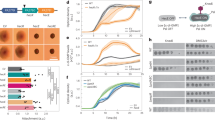Abstract
The dynamic interactions between a host and its intestinal microflora that lead to commensalism are unclear. Bacteria that colonize the intestinal tract do so despite the development of a specific immune response by the host1. The mechanisms used by commensal organisms to circumvent this immune response have yet to be established. Here we demonstrate that the human colonic microorganism, Bacteroides fragilis, is able to modulate its surface antigenicity by producing at least eight distinct capsular polysaccharides—a number greater than any previously reported for a bacterium—and is able to regulate their expression in an on–off manner by the reversible inversion of DNA segments containing the promoters for their expression. This means of generating surface diversity allows the organism to exhibit a wide array of distinct surface polysaccharide combinations, and may have broad implications for how the predominant human colonic microorganisms, the Bacteroides species, maintain an ecological niche in the intestinal tract.
This is a preview of subscription content, access via your institution
Access options
Subscribe to this journal
Receive 51 print issues and online access
$199.00 per year
only $3.90 per issue
Buy this article
- Purchase on Springer Link
- Instant access to full article PDF
Prices may be subject to local taxes which are calculated during checkout




Similar content being viewed by others
References
Macpherson, A. et al. A primitive T cell-independent mechanism of intestinal mucosal IgA responses to commensal bacteria. Science 288, 2222–2226 (2000).
Comstock, L. E. et al. Analysis of a capsular polysaccharide biosynthesis locus of Bacteroides fragilis. Infect. Immun. 67, 3525–3532 (1999).
Coyne, M. J., Kalka-Moll, W., Tzianabos, A. O., Kasper, D. L. & Comstock, L. E. Bacteroides fragilis NCTC9343 produces at least three distinct capsular polysaccharides: cloning, characterization, and reassignment of the PS B and PS C biosynthesis loci. Infect. Immun. 68, 6176–6181 (2000).
Coyne, M., Tzianabos, A., Mallory, B., Kasper, D. & Comstock, L. A polysaccharide biosynthesis locus required for virulence of Bacteroides fragilis. Infect Immun 69, 4342–4350 (2001).
Bayley, D., Rocha, E. & Smith, C. Analysis of cepA and other Bacteroides fragilis genes reveals a unique promoter structure. FEMS Microbiol. Lett. 193, 149–154 (2000).
Kim, J. et al. In vivo phase variation of Escherichia coli type 1 fimbrial genes in women with urinary tract infection. Infect. Immun. 66, 3303–3310 (1998).
Abraham, J., Freitag, C., Clements, J. & Eisenstein, B. An invertible element of DNA controls phase variation of type 1 fimbriae of Escherichia coli. Proc. Natl Acad. Sci. USA 82, 5724–5727 (1985).
Olsen, P. & Klemm, P. Localization of promoters in the fim gene cluster and the effect of H-NS on the transcription of fimB and fimE. FEMS Microbiol. Lett. 116, 95–100 (1994).
Thompson, J. S. & Malamy, M. H. Sequencing the gene for an imipenem-cefoxitin-hydrolyzing enzyme (CfiA) from Bacteroides fragilis. J. Bacteriol. 172, 2584–2593 (1990).
Acknowledgements
We thank W. Kalka-Moll for electron microscope photography and J. Daley and S. Lazo-Kallanian for assistance with FACS analysis. This work was supported by grants from the National Institutes of Health.
Author information
Authors and Affiliations
Corresponding author
Ethics declarations
Competing interests
The authors declare no competing financial interests.
Supplementary information
Rights and permissions
About this article
Cite this article
Krinos, C., Coyne, M., Weinacht, K. et al. Extensive surface diversity of a commensal microorganism by multiple DNA inversions. Nature 414, 555–558 (2001). https://doi.org/10.1038/35107092
Received:
Accepted:
Issue Date:
DOI: https://doi.org/10.1038/35107092
This article is cited by
-
Massively parallel single-cell sequencing of diverse microbial populations
Nature Methods (2024)
-
Diversity of sugar-diphospholipid-utilizing glycosyltransferase families
Communications Biology (2024)
-
The Role of Gut Dysbiosis and Potential Approaches to Target the Gut Microbiota in Multiple Sclerosis
CNS Drugs (2023)
-
Bacteroidales species in the human gut are a reservoir of antibiotic resistance genes regulated by invertible promoters
npj Biofilms and Microbiomes (2022)
-
Comparative genomics reveals genus specific encoding of amino acids by tri-nucleotide SSRs in human pathogenic Streptococcus and Staphylococcus bacteria
Biologia (2022)
Comments
By submitting a comment you agree to abide by our Terms and Community Guidelines. If you find something abusive or that does not comply with our terms or guidelines please flag it as inappropriate.



